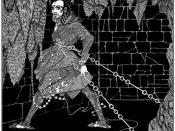Poe skilfully manipulates narrative techniques to create powerful, sophisticated and greatly varied impacts in character and setting. He is completely in control of the impact on the reader, and he uses this to his advantage to convey meaning in his writing.
A vital technique that Poe employs is voice, or the use of first person narrative. This is a tool that allows Poe to imply authority, and add depth to his characters. Voice is an excellent signifier of emotions. It allows for shifts in tone and pace, which mirror changes in the character's thoughts. Voice can imply the state of mind, attitudes and values of a character, and give insight to their mind, soul and spirit. Voice provides an opportunity to describe setting from a character's point of view, forcing the reader to believe and become a part of the story.
In 'The Tell-Tale Heart', the voice used is that of the murderer.
The voice is full of pride, vanity and egotism. The character is insane. The murderer is unstable and the reader cannot trust him. His tone is celebratory and revelatory. Through the use of voice, he portrays himself as psychotic, unsound and deranged. The reader is made to feel uncomfortable and disorientated.
The setting in 'The Tell-Tale Heart' is not described in great detail. The reader knows the events are taking place in the old man's house, and that there are neighbours relatively close by. The common gothic motif of darkness is used, and the reader takes this as a reason for the lack of detail. Poe has cleverly used voice to keep the reader's attention on the actual happenings of the story.
In 'The Cask of Amontillado', the voice is also that of the villain. The first person narrative allows the reader into Montressor's head to learn that he wants revenge. This is an excellent idea from Poe as the story can now be understood without the reason for revenge being clear. The reader can not see the logic in the crime, can not understand or relate to it. The ambiguity mesmerises the reader to become curious and engaged in the story. Montressor presents himself as manipulative and sly, and from his narration the reader learns his secrets and inner-most thoughts. Poe's first person narration offers an element that dialogue can not give.
The setting in 'The Cask of Amontillado' is extremely important. In the end, it is essentially the setting - the vaults - that bring Fortunato to his death. Voice allows for the foreshadowing in the story. The vaults are described as "insufferably damp" and "encrusted with nitre". Montressor advises Fortunato that it is a dangerous place for him, and that he should not go there, and due to the insight into Montressor's mind, the reader can understand that this is the setting for the revenge.
Another important technique that Poe uses is imagery. Poe's imagery applies to all senses, and the detail in which he presents his stories helps the reader to visualise the situation. His imagery is hugely varied, but is often bizarre and confronting.
In 'The Tell-Tale Heart', the imagery is strong and creates a very real picture for the reader. It is easy to imagine the killer sneaking into the dark room. Imagery plays an important role in establishing the setting in 'The Tell-Tale Heart'. The concept of darkness adds to the gothic themes of danger and harm, and the man's description of his movements only add to the reader's perception that he is indeed insane.
The imagery in 'The Tell-Tale Heart' is very focused on the sense of sound. It is the man's silence as he enters the room that alarms the reader the most, and it is the 'beating of the heart' that brings the murderer down. The repetitive references to sound are important in creating a real image of the story for the reader. The recurring motif of being watched is also a strong piece of imagery that helps to define the character. When hearing that the murderer has been watching the old man, the reader presumes he is unsound and crazy. These feelings are heightened by his claim that the old man's eye watches him. The audience feels he is demented and delusional.
In 'The Cask of Amontillado', imagery is comforting to the reader and gives a sense of normalcy. Beginning the story at a carnival and describing Fortunato there lessens the sense of impending doom. The setting is comfortable and therefore so is the reader, but when the action moves to the vaults, it is obvious that this mirrors a shift of power to Montressor, and Fortunato's shortcoming. The danger of the vaults reflects the danger Fortunato faces.
The reader's first impression of Fortunato is that he is not particularly sensible or serious, or to be taken seriously, due to the description of him as behaving drunkenly and being in fancy dress. He is presented as unreliable, and his credibility is in doubt. The detail with which Montressor plans helps the reader to understand that he is manipulative, crafty and sly. He is not a character to be trusted.
Poe intelligently manipulates techniques to gain versatility from them. The one technique can have hundreds of different impacts, and this is clearly evident in Poe's writing. His unique writings demonstrate immense skill and talent.
BibliographyThe Tell Tale Heart - Edgar Allan PoeThe Cask of Amontillado - Edgar Allan Poe



Essay
This is a very good essay which throughly explores all the techniques in the texts, however try and avoid repeatedly using the word 'in' in front of the titles of the two texts.
0 out of 0 people found this comment useful.